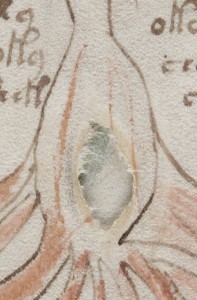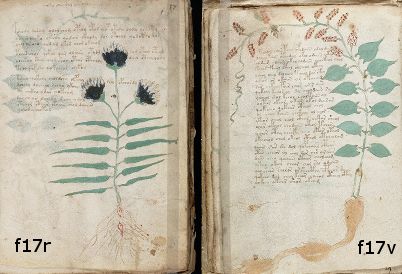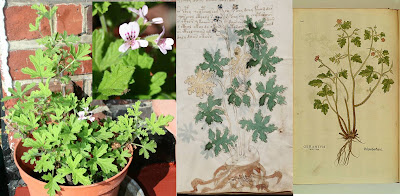On the one hand, “Linus’ Law” asserts that if enough people collaborate to solve a problem, it becomes simple – hence open source software. On the other, even though more people have eyeballed the Voynich Manuscript in the last two years (thanks to the Beinecke Library’s scans posted on the Internet) than in the previous four centuries, the overall level of discourse seems to have gone dramatically downhill over that same period.
I used to believe that everyone’s contribution was potentially worthwhile, because anyone might see a connection that helps to unlock a door: but this inclusive liberal viewpoint isn’t tenable any more, basically because you have to be able to read the VMs’ pictures in a pretty sophisticated way to get even close.

Even for the very brightest, there are numerous traps to fall in: such as Sergio Toresella’s belief that the hole rubbed through the tree-trunk-like thing on f34r signals the mad scribe’s sexual frustration (it would require a great deal of work to rub such a neatly arranged hole through vellum). Perhaps Sergio is right (he’s extremely close in almost every other way): but this presumes a very specific kind of irrationality – and so the observation relies very heavily on the hypothesis to validate it, which is a kind of circular argument.
All of which colours my reaction to Zachary1392’s post on the Facepunch Studios forums: when looking at the same hole rubbed through on f34r/f34v, he sees it as a representation of female genitalia. Which (having then thought about it some more) he then concludes we should perhaps worship, as part of a Voynich religion.
In some ways, it’s an optimistic moment: a very sophisticated opinion informed by Sergio Toresella’s lifetime of studying medieval herbals, being duplicated by some amusing forum troll. But it’s also a pessimistic moment, because it gets us nowhere: “Greeman” on the same forum similarly points out:
Haha it was probably some shmuck from 600 years ago who thought;
“I bet if I write some crazy letters and draw some real fucked up stuff on a book someone will find it years later and totally freak out.”
It worked, you all got trolled from an Ancient Pothead.
Good Game.
While “Trogdon” helpfully suggested that, because one word looks like “crop” (EVA chol), the VMs might instead be a Photoshop tutorial. And Draicia thinks the whole thing might be a viral advertisement (but for what? Another Dan Brown novel? Have book publishers suddenly evolved?)
I think that all this forum chatter demonstrates something quite basic: that Linus’ Law sucks for things you can’t easily decompose. Reductionism is such a fundamental tenet of scientific thought that nobody even thinks to mention it these days – but the awkward dizzying truth is that to get started on difficult problems, scientists actually have to actively exercise their scientific imagination to generate novel decompositions (which may or may not be right), within which the hard slog of execution can be split up amongst a virtual cloud of volunteers / academics / workers. Hence string theory, etc.
Linus’ Law fails for the VMs because nobody wants to sign up to any apparently mad theory before committing any serious amount of effort to testing it. But the truth underlying such an odd object will most likely appear somewhat alien (if not outright demented) to our present day minds – and so any person proposing the hypothesis is naturally expected to do all the hard work of proving it.
The sad thing about the VMs is that we do now have a collection of basic art historical facts and observations which tell us broadly where and when the VMs came from: but these point to so prosaic a subset of answers that almost nobody wants them to be true. Far more interesting to put your trust in David Icke’s, Dan Burisch’s, or Gordon Rugg’s brand of alternate history: they’re scientists, aren’t they? (Errrrrrrm…)
Put it all together, and I think the wisdom of the crowded forums perhaps points to the antithesis of Linus’ Law: that if enough people help to trample on every suggestion, nothing is simple. Or perhaps even simpler: given enough troll eyeballs, everything becomes worthless junk. Oh well. 🙁



